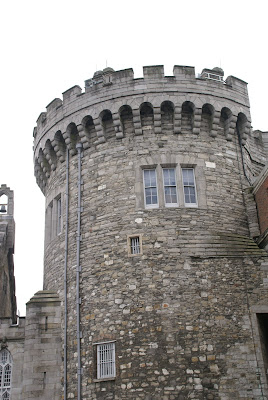Day 2:
To get some of the history of Ireland, we took a Historical Walking Tour of Dublin.
Our guide was Lisa.
For a brief history of Ireland, see here: http://www.bbc.co.uk/dna/h2g2/A707906
Go ahead, take a look. I'll wait......Really, it's no problem....
First we ran in to Molly Malone...little did we know we would see her on the "Hop on Hop off bus" about 300 more times...Molly is commemorated in a statue designed by Jeanne Rynhart, erected to celebrate the city's first millennium in 1987. Placed at the top of Grafton Street in Dublin, this statue is known colloquially as "The Tart With The Cart," "The Dish With The Fish," and "The Trollop With The Scallops."
The first stop on our tour was the former parliament building (when the Irish were still under British Rule) but is now a bank.
Dublin Tourist tells us:
The prestigious offices of Ireland's national bank began life as the first purpose-built parliament house in Europe. Completed in 1739 it served as Ireland's Parliament until the Act Of Union in 1801 this imposed direct rule on Ireland from London. Today attendants lead tours that point out the coffered ceiling and oak panelling. There are also huge tapestries of the Battle of the Boyne and the siege of Derry, and a splendid 1,233-piece crystal chandelier dating from 1788.
The former room used for upper house of the parliament is still open to the public.
Next stop was City Hall:
Erected between 1769 and 1779, and formerly the Royal Exchange. It is a square building in Corinthian style, with three fronts of Portland stone. Since 1852, however it has been the centre of the municipal government. The interior is designed as a circle within a square, with fluted columns supporting a dome shaped roof over the central hall. The building contains many items of interest, including 102 royal charters and the mace and sword of the city.
View looking up in the lobby:
Next stop was Dublin Castle:
Built between 1208 and 1220, this complex represents some of the oldest surviving architecture in the city, and was the centre of English power in Ireland for over seven centuries until it was taken of by the Irish Free State in 1922. Highlights include the 13th-century record tower, the largest visible fragment of the original Norman castle and the State Apartments, once the residence of English viceroys and now the focal point for government ceremonial functions, including the inauguration of Ireland's presidents. The newest developments for visitors are the Undercroft, and excavates site on the grounds where an early Viking fortress stood, and the treasury, built between 1712 and 1715, believed to be the oldest surviving purpose-built office building in Ireland.
I'll show you the most castley-looking part of Dublin Castle:
After the tour we walked down O'Connell Street in the heart of Dublin:
Wikipedia tells us:
On the site of the Pillar (blown up in 1966), a new monument was erected in January 2003. Officially named the Spire of Dublin, this tall needle-like structure has already received a number of nicknames including The Spike, The Binge Syringe, The Stiletto in the Ghetto, The Nail in the Pale (see the Pale), The Pin in the Bin, The Stiffy at the Liffey, and The Erection in the Intersection.

"The great appear great because we are on our knees: Let us rise."













1 comment:
I love Ireland!
Post a Comment